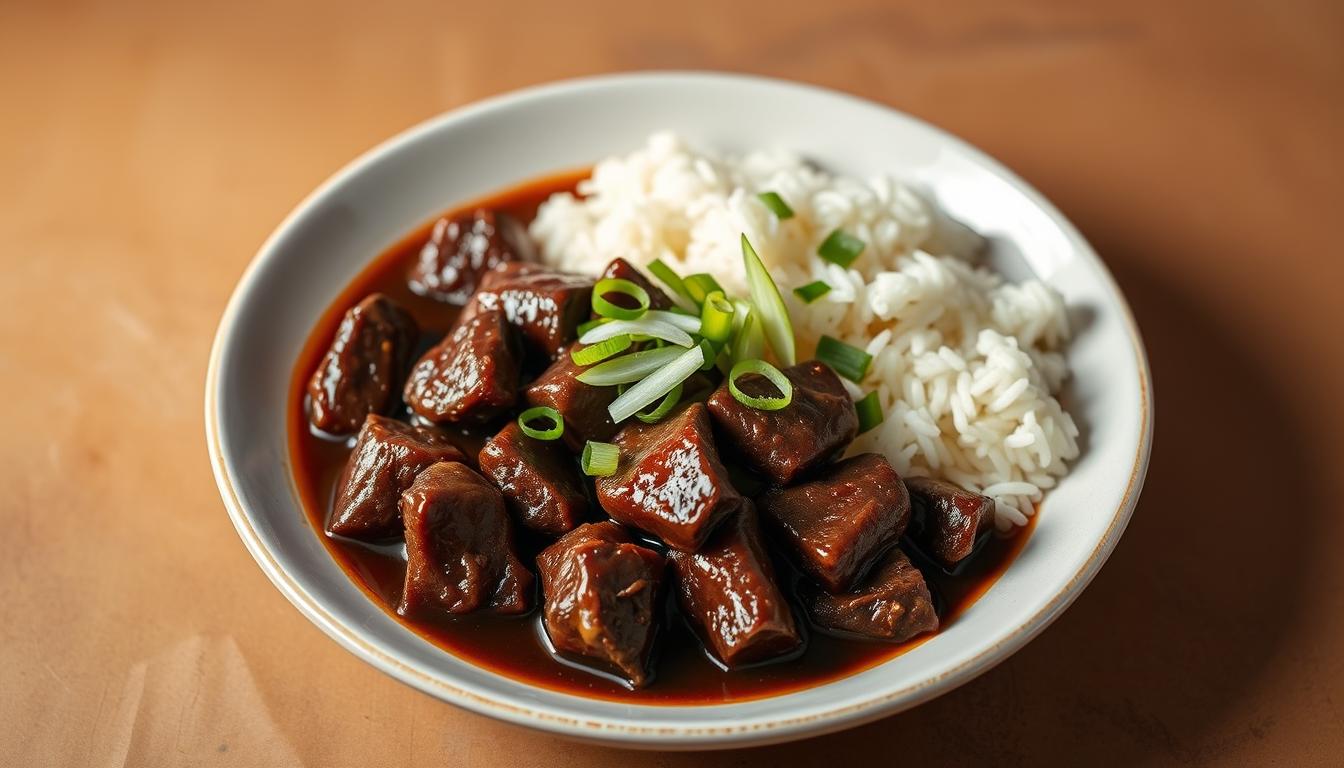Growing up in a Filipino household, I remember the tantalizing aroma of beef stew wafting through our kitchen. This smell instantly took me to the bustling street-side diners of Manila. Pares is a culinary treasure that embodies the heart and soul of Filipino comfort food.
So, what are pares? At its core, pares is a quintessential Filipino dish. It combines tender braised beef asado, fragrant garlic fried rice, and a clear, warming beef broth. The term “pares” means “pairs” in English, perfectly describing how these elements come together to create a harmonious and satisfying meal.
Originating from humble street-side eateries called paresan, this dish has become a beloved staple in Filipino cuisine. Whether you’re a hungry worker grabbing a quick lunch or a food enthusiast exploring Filipino flavors, pares offers a delicious glimpse into the country’s rich culinary heritage.
Table of Contents
The History and Origin of Filipino Pares
Filipino cuisine is filled with delicious dishes, and pares is a favorite comfort food. It has a rich history. This dish started as street food and became a national favorite.
The story of pares began in the late 1970s. It was started by Filipino food entrepreneurs. Lolita Tiu, a pioneering restaurateur, opened the first paresan in Quezon City.
The Birthplace of Pares
In 1979, Lolita Tiu and Roger Tiu opened Jonas carinderia. It was at Mayon Street and Malindang Street. This small eatery was where “pares” was first used and became a big hit.
From Street Food to Culinary Staple
Pares quickly became a favorite dish across the country. Different versions of pares were created, offering a variety of flavors and styles:
- Pares Kanto: Traditional street-style version
- Pares Mami: Featuring egg noodles
- Pares Overload: Modern variation with extra toppings
Cultural Significance
Pares is more than just food; it’s a symbol of Filipino creativity and resourcefulness. It brings people together, offering comfort and community in every bite. It shows how Filipino street food culture adapts and evolves.
“Pares is not just food; it’s a culinary story of innovation and tradition.” – Filipino Food Historian
What Are Pares: Understanding the Basic Components
Pares is a beloved Filipino comfort food. It combines three essential components in a delightful way. This dish is more than just a meal; it’s a cultural expression of Filipino cooking.
Exploring pares means looking at its core ingredients. These ingredients work together to create a satisfying dining experience. The dish’s simplicity is what makes it special.
Beef Asado: The Centerpiece of Flavor
The beef asado is at the heart of pares. It’s a tender meat preparation that defines the dish’s character. The beef is braised in a sweet-soy sauce, creating a rich flavor that melts in your mouth.
- Slow-cooked until fork-tender
- Marinated in a sweet-soy sauce blend
- Typically made with beef brisket or beef shanks
Garlic Fried Rice: The Perfect Companion
Sinangag, or garlic fried rice, is the perfect accompaniment to the beef asado. It’s made with fragrant Jasmine rice and topped with crispy fried garlic. This adds texture and an aromatic dimension to the dish.
Clear Beef Broth: The Comforting Finish
The final element of pares is a clear beef broth. It ties everything together. Simmered with traditional spices like onion, garlic, and bay leaves, the broth offers a light yet flavorful complement to the rich beef and rice.
Pares in medicine has been informally noted as a comfort food that helps recovery, after long nights or as a hearty meal.
Traditional Preparation Methods and Techniques
Making authentic pares is all about mastering cooking techniques. These methods turn simple ingredients into a tasty Filipino comfort food. Learning how to prepare pares starts with understanding these key steps.
The beef preparation is key for a tender and flavorful pares. Chefs focus on these steps:
- Select a high-quality beef cut like brisket or tri-tip
- Cut meat into 1½-inch cubes for even cooking
- Blanch beef for 8-10 minutes to ensure a clear broth
- Slow-cook the meat for 2 to 2.5 hours until tender
The cooking process involves simmering beef in a flavorful liquid. There are two main ways to do this:
- Traditional method: Using the meat’s natural cooking liquid
- Alternative method: Utilizing beef bouillon cubes for quick preparation
To make the garlic fried rice, use ¼ cup canola oil and 5 minced garlic cloves. This mix creates a crispy, aromatic base that goes well with the savory beef.
Pro tip: Reserve 1 cup of broth for enhancing the beef asado’s flavor profile.
Proper storage is key. Refrigerate your pares for up to 3 days or freeze for 2 months. This keeps its taste and texture great.
Essential Ingredients for Authentic Pares
Making the perfect pares needs the right ingredients. These ingredients bring out the rich flavors of this Filipino comfort food. The mix of meat, spices, and broth turns a simple dish into a masterpiece.

Meat Selection and Preparation
The meat choice is key in pares. Traditional recipes use 1 kilo of beef brisket, cut into cubes. This cut is tender and flavorful.
Experts say the right meat prep is crucial. It can make or break the dish.
- 1 kilo beef brisket, cubed
- 5 cloves of garlic
- 1 large onion, chopped
- 1 tablespoon grated ginger
Spices and Seasonings
The magic of pares is in its spices. The right seasonings add depth to the flavor.
- 1/2 cup soy sauce
- 1/2 cup brown sugar
- 2 pieces star anise
- 1 teaspoon ground pepper
- Optional: 1 teaspoon sesame oil
Broth Components
The broth is pares’ soul, blending all flavors. Traditional recipes use aromatics and liquids for a rich base.
- 4 cups water
- 2 tablespoons cooking oil
- 2 chopped scallions for garnish
Pro tip: For tender meat, cook in a slow cooker for 6-8 hours. This lets flavors meld and meat become tender.
Popular Variations of Filipino Pares
Filipino cuisine is all about making classic dishes new again. Pares, a traditional beef stew, is no different. Street food culture has brought us many tasty pares examples that everyone loves.
Some popular pares variations include:
- Pares Kariton: A street-style version served by mobile vendors, featuring a slightly thickened beef broth
- Pares Kanto: Roadside version known for its convenient serving style
- Pares Mami: A noodle-based adaptation combining beef stew with egg noodle soup
- Pares Overload: A decadent version featuring additional proteins like fried pork lechon and chicharong bulaklak
Each variation shows the creativity of Filipino street food vendors. It also shows how tastes are changing. Whether you like the classic or something more elaborate, these pares examples highlight the dish’s versatility.
Explore the rich culinary landscape of Filipino street food through these unique pares interpretations!
The Art of Making Perfect Beef Broth
Making great beef broth is key to treating pares right. It needs careful steps to get a clear, tasty base that makes the dish better.
Blanching Techniques for Clean Flavor
Blanching is the first step in making pares. Start by boiling 1 kg of beef neck meat, then cool it down fast in ice water. This removes bad stuff and makes the broth clean and pure.
Achieving Crystal Clear Broth
To get a clear broth, follow these steps:
- Use gentle simmering instead of rolling boil
- Skim foam and impurities regularly
- Avoid stirring the meat during cooking
- Strain the broth through a fine-mesh sieve

Seasoning and Aromatics
Boost your broth with these classic seasonings:
- 1 tsp black pepper
- 1 tsp salt
- 1 tablespoon Chinese rice wine (optional)
- Bay leaves
- Whole onions
Pro tip: Roasting bones before simmering adds a richer flavor. It makes the taste more complex.
Serving and Presentation Styles
Enjoying pares is more than just eating. It’s about the art of presentation. Different styles can make your meal a special journey.
Traditional pares have three main parts. They work together to create a perfect taste:
- Beef Asado (tender braised beef)
- Garlic Fried Rice (Sinangag)
- Clear Beef Broth
Garnishes are key in pares presentation. Chefs add chopped green onions and crispy fried garlic. They make the dish look good and taste even better.
“The beauty of pares lies in its simplicity and the artful way it’s served” – Filipino Food Enthusiast
Pares can be served in many ways. Some places mix the beef and broth together. Others keep them apart. You might also find steamed rice instead of garlic fried rice, depending on your taste.
The goal is to make a plate that looks and tastes great. Whether it’s traditional or modern, pares has something for everyone.
From Street Food to Restaurant Favorite
Filipino cuisine is growing, with pares becoming a big hit. It started in small Tapsilogan eateries in the mid-20th century. Now, it’s loved by many in Filipino-American communities.
This dish has kept its true taste while getting new twists. It shows how comfort food can stay true to its roots but also grow.
Now, pares is found in fancy restaurants, not just street stalls. Chefs are adding new touches, like fried pork lechon. This makes pares exciting for food lovers looking for something new.
Social media has helped make pares famous. It shows how important it is to people everywhere. Chefs are trying new ways to serve it, keeping it fresh and interesting.
Pares is still a favorite, whether in a busy carinderia or a fancy restaurant. Its journey shows how a simple dish can bring people together. It’s a story of tradition and innovation in Filipino food.
FAQ
What exactly is pares?
Pares is a beloved Filipino comfort food. It has three main parts: beef asado, garlic fried rice, and clear beef broth. The name “pares” means “pairs” in English, showing the mix of these three.
Where did pares originate?
Pares started in the late 1970s in the Philippines. Lolita Tiu is credited with inventing the term and opening the first paresan. It began as street food and grew into a favorite dish.
What makes the beef in pares special?
The beef in pares is cooked as beef asado. It’s slow-cooked until tender and seasoned with sweet-soy sauce. The tender cuts make it melt-in-your-mouth.
Are there different variations of pares?
Yes, there are many variations. You can find pares kariton (street cart style), pares mami (with egg noodles), and pares overload (with extra fried pork and chicharong bulaklak). Each offers a unique take on the classic dish.
How is traditional pares typically served?
Traditional pares comes with three parts: beef asado, garlic fried rice, and clear beef broth. It’s garnished with green onions and fried garlic for extra flavor and look.
What are the key ingredients in pares?
Key ingredients include beef, garlic, onions, soy sauce, bay leaves, peppercorns, and seasonings. The broth also has chives and onion leeks for flavor.
Is pares considered a street food or restaurant dish?
Pares is both a street food and a restaurant dish. It started on the streets and now is found in casual and upscale places. Specialized paresan restaurants focus on serving it.
How long does it take to prepare traditional pares?
Making authentic pares takes several hours. The beef asado needs slow cooking for tenderness and flavor. The broth and rice preparation add to the time.
Can pares be made at home?
Yes, you can make pares at home. It needs skill and patience, but with quality beef and slow cooking, you can get it right. Pay attention to seasoning the meat and broth.
What makes pares a comfort food in Filipino cuisine?
Pares is more than food; it’s a comfort that brings people together. It offers a satisfying experience that shows Filipino culinary creativity and ingenuity.
Source Links
- Here’s Where to Eat Beef Pares Mami Around Metro Manila – https://thebeat.asia/manila/delish/happenings/ready-your-tummies-heres-where-to-eat-beef-pares-mami-around-metro-manila
- How to cook beef Pares a famous street food now in the Philippines – Travel and food in Philippines – https://foodandtravelph.com/index.php/2024/05/07/how-to-cook-beef-pares-a-famous-street-food-now-in-the-philippines/
- How To Cook Beef Pares with Lechon Kawali and Chicharon Bulaklak – https://www.mustseephilippines.com/2024/07/How-To-Cook-Beef-Pares.html
- Beef Pares – https://getrecipe.org/beef-pares/
- Beef Pares Recipe | Panlasang Pinoy Meaty Recipes – https://www.panlasangpinoymeatrecipes.com/beef-pares-recipe.htm
- Pares (food) – https://en.wikipedia.org/wiki/Pares_(food)
- Filipino Beef Pares (Braised Beef) – Kusina Secrets – https://kusinasecrets.com/filipino-beef-pares-braised-beef/
- Beef pares – sample this Filipino staple here in SLC – https://gastronomicslc.com/2024/11/04/beef-pares-sample-this-filipino-staple-here-in-slc/
- Beef Pares – https://www.kawalingpinoy.com/beef-pares/
- Beef Pares Recipe – https://getrecipe.org/beef-pares-recipe/
- Retiro Beef Pares with Chicharon Bulaklak – https://panlasangpinoy.com/retiro-beef-pares-with-chicharon-bulaklak/
- Beef Pares Recipe: A Flavorful Filipino Delight – https://www.miraclerestaurantgroup.com/beef/beef-pares-recipe/
- Beef Pares Recipe: A Filipino Comfort Food Classic – https://onestophalal.com/blogs/info/beef-pares-recipe-a-filipino-comfort-food-classic
- Filipino Beef Pares Recipe – The Recipe Website – https://therecipe.website/filipino-beef-pares/
- Mama’s Pressure Cooker Beef Pares ~ Relax Lang Mom – https://relaxlangmom.com/mamas-pressure-cooker-beef-pares/
- Sip Your Way to Better Health: How to Make Homemade Nourishing Bone Broths for Cold Winter Days – https://www.theepochtimes.com/bright/sip-your-way-to-better-health-how-to-make-homemade-nourishing-bone-broths-for-cold-winter-days-5787673
- 84 Pressure-Cooker Recipes – https://www.tasteofhome.com/collection/pressure-cooker-recipes/?srsltid=AfmBOor5_C31oWLG81GSdLWFIzsO_RF3_rWkx7xMVt6FsEWMDGzEllb0
- LP Culinary Service Styles – Convivial Catering – https://convivialcatering.com/culinary-service-styles2/
- Elevate Your Cheese Platter: Creative Presentation Ideas and Serving Techniques – https://cheeseitup.timesfoodie.com/know-your-cheese/elevate-your-cheese-platter-creative-presentation-ideas-and-serving-techniques-article-108440887
- Easy Filipino Beef Pares Recipe For Comfort Food – https://www.tastemeats.com/filipino-beef-pares/









